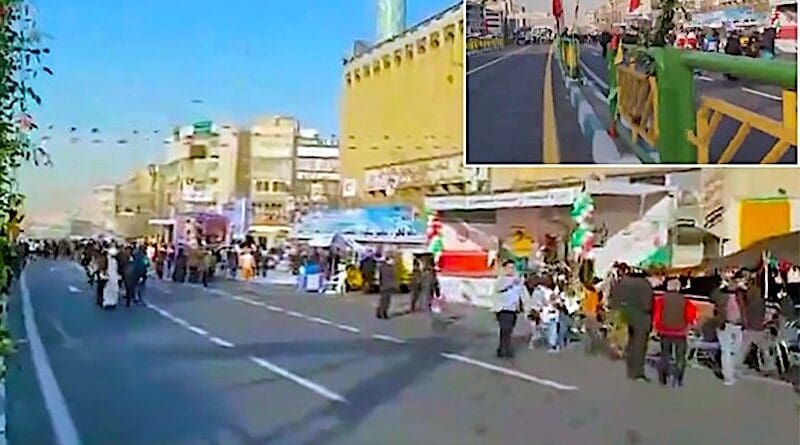Iran: Inside The Pro-Regime Rallies On Anniversary Of 1979 Revolution – OpEd
By Matin Karim
Iran’s regime goes to great lengths to twist the truth and present a false image of itself. And it spends huge amounts on propaganda efforts to create an illusion of popular support for the despotic rule of the mullahs. Meanwhile, even the regime’s own officials and insiders are warning about the threat of popular uprisings and widespread boycotts in the upcoming parliamentary elections.
These days, different social strata in Iranian cities are demanding basic living standards from the regime. A common slogan that is being repeated in protests is, “We haven’t seen justice, only lies.”
For forty-five years, “only lies” have been used to preserve the regime’s hold on power.
The regime is using the anniversary of the 1979 revolution as an annual showcase of its latest deception and falsehoods. State media and government-affiliated experts predicted that only regime loyalists would participate in the regime’s rallies.
However, this year, the regime broke its own records in staging pro-government rallies and creating an impression of participation. But the reality, as reported by reporters of PMOI website, paint a different picture.
Tehran
February 11, 2024
“At 8:30 am, I took the bus towards the Navvab-Azadi intersection to gather information for my report. When we reached Jomhuri Square, the bus was stopped. They told us to disembark right there. The passengers inside the bus, each preoccupied with their own tasks, began to express their frustration and discontent with the inconvenience. However, it was to no avail. Everyone was forced to disembark, creating a mass of people on the streets. These individuals unintentionally became subjects of the spectacle wherever they went, and the cameras were in pursuit.
“I walked from there to Navvab intersection and then directly from Forsat Street towards Enghelab Street. The streets were filled with officers, both in uniform and plainclothes. They had closed off all the routes leading to Enghelab Street to prevent any vehicle from passing through. I walked a little further and saw a group of people in civilian clothes having breakfast. I entered Enghelab Street and headed towards Valiasr intersection. From the other side of the street, I went towards Azadi Square.
“At that time, there was no news yet. People were being brought in one by one, and they were walking in a procession, in a march. Previously, they would set up stalls on one sidewalk. But this year, both sidewalks were lined with stalls selling sandwiches, lentil soup, and other foods. Those who had come were either members of the Basij and the Revolutionary Guards or students from schools, or they were from the outskirts of Tehran and distant cities, and some were even homeless individuals. Amidst this crowd, I also saw a group of Afghans who had arrived by bus. I had seen their buses in Jomhuri Square and the surrounding streets of Enghelab and Azadi.
“Suddenly, I saw a few young girls born in the 1990s and 2000s walking without the forced hijab. One of them had a short open-front jacket that reached her waist, with a hat and long disheveled hair. Another girl had heavy makeup on, with a style that would have drawn attention if seen on the metro, unequivocally would be beaten to death.
“They had blocked the pedestrian bridges to prevent anyone from going towards the street. This forced people to pass through the makeshift camps set up on the bridges to create the impression of a larger crowd in the middle of the street. I took the escalator between the BRT station and Enghelab Street to go up towards Azadi Square. However, the electricity was cut off, so I had to climb the escalator manually. The pedestrian bridge was right in front of the building of the Ministry of Labor and Social Affairs. Some Basij members and plainclothes Revolutionary Guards were standing there, blocking the other side of the bridge, which led to the other side of the street. I filmed scenes from both directions while I was up there. The scenes were quite captivating, with no resemblance to a march or protest. Even the regime supporters and hired participants were fewer compared to the previous year. Afterward, I went back down and walked among the crowd towards the pedestrian walkway.
“They had gathered a group of people, both from themselves and from the outskirts of Tehran. They all rushed to the food stalls, trying to grab as many food items as possible. They eagerly grabbed fruit juices, cakes, lentil soup, porridge, semolina, and anything edible that was available.”
Through these efforts, the regime seeks to display its legitimacy, as acknowledged by its leaders themselves, who admit that the regime’s security depends on the support of the masses and their presence at the ballot boxes. The current situation is very critical for the regime, as it realizes its survival and durability are contingent upon a favorable electoral outcome, which indicates popular acceptance and legitimacy.
These empty and futile tricks no longer have the power to sustain this fragile, bankrupt, and crumbling regime, which has been pushed to the brink of collapse by the relentless blows of uprisings and the presence of rebellious youth. The deplorable conditions prevailing in Iran leave no prospect other than overthrow. The conditions themselves echo the cry for the end of Iran’s calamitous era.

